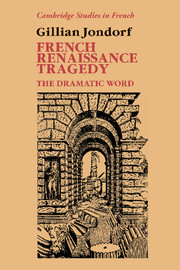4 - The Chorus
Published online by Cambridge University Press: 22 September 2009
Summary
We know tantalisingly little about how the humanist dramatists used, or wished to use, their Chorus on stage. Writing about the Chorus in Garnier's Les Juifves, R. M. Griffiths says firmly: 'The Chœur des Juifves is, like all Renaissance choruses, present on the stage throughout the action' (1986,57); but it is by no means certain that this is true of 'all Renaissance choruses'. Françoise Charpentier (1981, 575) holds that in plays of Montchrestien where the Chorus is 'personnalisé' (La Reine d'Escosse, Les Lacènes), there must also be a 'Chœur impersonnel', although this is not mentioned in the list of 'Entreparleurs'; but this too is only surmise. Charpentier also speculates about the deployment of the Chorus on the stage: 'Sur la scène même, il faut imaginer les acteurs du Chœur en retrait, opérant, au moment de prendre la parole, un mouvement pour occuper le devant de la scène, et peut-être masquer les déplacements des autres acteurs en train de l'évacuer.'
The continuous presence of the Chorus is one way of both imposing and guaranteeing the unities of time and place; but even if we assume that once the Chorus appeared it remained on stage for the rest of the play (and this seems unlikely in plays with multiple Choruses, such as Garnier's Antigone), we need not necessarily suppose that it appeared as soon as the play began.
- Type
- Chapter
- Information
- French Renaissance TragedyThe Dramatic Word, pp. 65 - 86Publisher: Cambridge University PressPrint publication year: 1990



